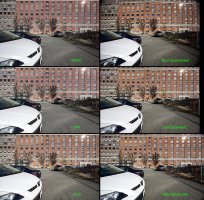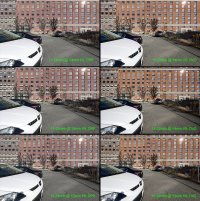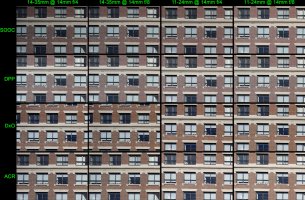L
Loswr
Guest
Mirrorless cameras lack an optical viewfinder, so looking through the lens is always an electronic process. This fact enables lens manufacturers to include consideration of digital optical corrections in their lens designs and make trade-offs accordingly – more optical aberrations can be tolerated because they will be corrected in the EVF and in processed images, so users will often not know they’re there in the first place.
MILC manufacturers other than Canon have leveraged this concept for many years. Canon’s implementation in the RF 24-240mm lens came as a surprise to many when it was initially reported on internet forums, with the lens having very strong barrel distortion at the wide end and forcing the application of correction in-camera and in DPP (i.e., unlike other lenses the correction cannot be disabled). The recently released RF 16mm f/2.8 is similar, and that is probably not surprising in a $300 UWA lens (in fact, most likely the design trade-off of strong distortion is one reason the lens is so relatively inexpensive). Canon seems to have confirmed this with their statement in the press release for the lens, “Long gone are the days of optical corrections…,” presumably because digital corrections are now the norm.
However, Canon also took this approach with the RF 14-35mm f/4L IS, their first time doing so with an L-series lens. Although I had some concerns about this level of correction, I decided to swap my EF 16-35/4L IS for it, in part for the smaller size and in part for the wider FoV when I don’t want to bring the EF 11-24/4L.
Lens in hand, I decided to see how bad the distortion really is, and how well it can be corrected with various RAW converters. I used the classic brick wall test, but rather than standing close I opted for a more distant shot where the ‘wall’ was the side of a 9-story building at a distance that captured most of the height. The reason for that was to avoid the potential issue of focus breathing, where the effective focal length of a lens is shorter with a close subject (one example of this is Canon’s 100L Macro, where at 1:1 it’s giving the framing of ~68mm). Note that in his image testing, Bryan of TDP indicates that framing his ‘enhanced ISO 12233’ chart at 14mm is done at a distance of less than 2’ / 60 cm. I ensured that the camera was level and orthogonal to the building to avoid vertical and horizontal distortions.
The first composite is a set of RAW conversions of the same single image, taken at 14mm f/8 (thumbnail below is a 1000 pixel wide image hosted on CR, full image is HERE).

The top right image was converted in DxO PhotoLab with all corrections turned off. The uncorrected image shows significant barrel distortion and some mechanical vignetting in the corners. Compared to the straight out of camera JPG (top left), the FoV of the uncorrected image is clearly wider than 14mm (how much wider is discussed below). In DPP, I converted the image with corrections set to 100% and with DLO. The FoV is the same as the SOOC image, but the vignetting correction is improved. Converting the image in Adobe Camera Raw with the lens profile yields a slightly wider FoV than with Canon’s lens profile (e.g., more of the window lintels are visible in the upper left corner, and the left edge of an additional column of windows is visible on the right edge. The standard (default) corrections in DxO deliver a noticeably wider FoV than ACR – another row of windows becomes visible in the top left and an additional full column of windows is visible on the right side. DxO also has an ‘optical corrections only’ option which does not force the corrected image into the original 3:2 aspect ratio, and the result there (bottom right) is an image of the same vertical FoV as standard but a wider horizontal FoV (another half-column of windows on the left). That image output is 305 pixels wider than the EOS R’s native output.
How much wider is the FoV of the corrections with DxO? To assess that, I took a series of images from 14mm down to 11mm on the EF 11-24mm. Shown is the comparison of the RF 14-35mm at 14mm (middle panels) with the EF 11-24mm at 14mm (top) and 13mm (bottom), converted with either DPP or DxO (thumbnail below is a 1000 pixel wide image hosted on CR, full image is HERE).

When converted with DPP, the FoV of the 14-35mm at 14mm is very slightly narrower than that of the 11-24mm at 14mm (where distortion is very modest). With DxO, the FoV of the 14-35mm at 14mm is comparable to ~13.5mm on the 11-24mm lens, meaning with optimal corrections the lens is delivering a wider-than-specified FoV. I’ll take it!
For the uncorrected image, based on the ‘corners’ of the strongly distorted image to the series of images taken from 14mm to 11mm on the EF 11-24mm, the FoV of the 14-35mm at 14mm approximates slightly under 13mm.
On this and other forums, there have been ‘tests’ that suggest the image from this and other strongly distorted lenses are cropped and then upscaled (I initially thought this might be the case, but it isn’t). These tests suffer from one or more flaws. A common approach prior to the availability of a lens profile from Adobe has been to drag the distortion slider to 100 then crop the image to the proportions of the in-camera JPG. However, when performing a manual correction for barrel distortion in LR/PS/ACR, dragging the slider to +100 does not equate to correcting 100% of the distortion. Rather, the slider is merely an arbitrary scale of 100 units of correction in the (+) direction for correcting barrel distortion or in the (–) direction for correcting pincushion distortion. In other words, +100 is likely too much correction. In the case of the 14-35mm at 14mm, around +35 to +40 does a reasonable job of correcting the barrel distortion.
Manual distortion correction assumes the characteristic of the distortion is linear (along the image radial), and that's almost never going to be the case. So, if you drag the distortion correction slider to the point where horizontal lines in the corners of the scene appear horizontal in the image, then there is residual barrel distortion of lines in the mid-frame. Conversely, if you drag the distortion correction slider to the point where horizontal lines in the mid-frame of the scene appear horizontal in the image, pincushion distortion of lines in the corners is introduced. Basically, manual distortion correction is applying a linear process to a non-linear aberration.
That's where lens profiles come into play. Applying the lens profile for the 14-35/4 in ACR and other RAW converters results in horizontal lines in both the corners and the mid-frame appearing horizontal in the image, i.e., the profile includes a non-linear correction for distortion. The same can be achieved in Photoshop using a warp transform, for example. In the case of an even more complex distortion (e.g., mustache) a warp-type transformation is really the only way it can be corrected. Doing so does 'stretch' the corners of the image, so in that sense there are 'fake pixels' being created, but it allows geometric correction without the need to crop then upscale the image.
That begs the question of how detail-destructive that warping correction is in practice. Below are 100% crops (1000x667 pixels) from the extreme upper left corner of the corrected 14-35mm images at f/4 and f/8, along with crops from the 11-24mm corners, also corrected but with much less correction required because of the better optical correction in the lens (thumbnail below is a 1000 pixel wide image hosted on CR, full image is HERE).

There are differences between the RAW converters but overall, the results in all cases are quite good, with very subtle differences if any between the highly corrected 14-35mm corners and the lightly corrected 11-24mm corners.
Based on the above, I’m more than satisfied with my new RF 14-35mm f/4L IS (and I recommend DxO PhotoLab for those wanting to get the most from it).
MILC manufacturers other than Canon have leveraged this concept for many years. Canon’s implementation in the RF 24-240mm lens came as a surprise to many when it was initially reported on internet forums, with the lens having very strong barrel distortion at the wide end and forcing the application of correction in-camera and in DPP (i.e., unlike other lenses the correction cannot be disabled). The recently released RF 16mm f/2.8 is similar, and that is probably not surprising in a $300 UWA lens (in fact, most likely the design trade-off of strong distortion is one reason the lens is so relatively inexpensive). Canon seems to have confirmed this with their statement in the press release for the lens, “Long gone are the days of optical corrections…,” presumably because digital corrections are now the norm.
However, Canon also took this approach with the RF 14-35mm f/4L IS, their first time doing so with an L-series lens. Although I had some concerns about this level of correction, I decided to swap my EF 16-35/4L IS for it, in part for the smaller size and in part for the wider FoV when I don’t want to bring the EF 11-24/4L.
Lens in hand, I decided to see how bad the distortion really is, and how well it can be corrected with various RAW converters. I used the classic brick wall test, but rather than standing close I opted for a more distant shot where the ‘wall’ was the side of a 9-story building at a distance that captured most of the height. The reason for that was to avoid the potential issue of focus breathing, where the effective focal length of a lens is shorter with a close subject (one example of this is Canon’s 100L Macro, where at 1:1 it’s giving the framing of ~68mm). Note that in his image testing, Bryan of TDP indicates that framing his ‘enhanced ISO 12233’ chart at 14mm is done at a distance of less than 2’ / 60 cm. I ensured that the camera was level and orthogonal to the building to avoid vertical and horizontal distortions.
The first composite is a set of RAW conversions of the same single image, taken at 14mm f/8 (thumbnail below is a 1000 pixel wide image hosted on CR, full image is HERE).

The top right image was converted in DxO PhotoLab with all corrections turned off. The uncorrected image shows significant barrel distortion and some mechanical vignetting in the corners. Compared to the straight out of camera JPG (top left), the FoV of the uncorrected image is clearly wider than 14mm (how much wider is discussed below). In DPP, I converted the image with corrections set to 100% and with DLO. The FoV is the same as the SOOC image, but the vignetting correction is improved. Converting the image in Adobe Camera Raw with the lens profile yields a slightly wider FoV than with Canon’s lens profile (e.g., more of the window lintels are visible in the upper left corner, and the left edge of an additional column of windows is visible on the right edge. The standard (default) corrections in DxO deliver a noticeably wider FoV than ACR – another row of windows becomes visible in the top left and an additional full column of windows is visible on the right side. DxO also has an ‘optical corrections only’ option which does not force the corrected image into the original 3:2 aspect ratio, and the result there (bottom right) is an image of the same vertical FoV as standard but a wider horizontal FoV (another half-column of windows on the left). That image output is 305 pixels wider than the EOS R’s native output.
How much wider is the FoV of the corrections with DxO? To assess that, I took a series of images from 14mm down to 11mm on the EF 11-24mm. Shown is the comparison of the RF 14-35mm at 14mm (middle panels) with the EF 11-24mm at 14mm (top) and 13mm (bottom), converted with either DPP or DxO (thumbnail below is a 1000 pixel wide image hosted on CR, full image is HERE).

When converted with DPP, the FoV of the 14-35mm at 14mm is very slightly narrower than that of the 11-24mm at 14mm (where distortion is very modest). With DxO, the FoV of the 14-35mm at 14mm is comparable to ~13.5mm on the 11-24mm lens, meaning with optimal corrections the lens is delivering a wider-than-specified FoV. I’ll take it!
For the uncorrected image, based on the ‘corners’ of the strongly distorted image to the series of images taken from 14mm to 11mm on the EF 11-24mm, the FoV of the 14-35mm at 14mm approximates slightly under 13mm.
On this and other forums, there have been ‘tests’ that suggest the image from this and other strongly distorted lenses are cropped and then upscaled (I initially thought this might be the case, but it isn’t). These tests suffer from one or more flaws. A common approach prior to the availability of a lens profile from Adobe has been to drag the distortion slider to 100 then crop the image to the proportions of the in-camera JPG. However, when performing a manual correction for barrel distortion in LR/PS/ACR, dragging the slider to +100 does not equate to correcting 100% of the distortion. Rather, the slider is merely an arbitrary scale of 100 units of correction in the (+) direction for correcting barrel distortion or in the (–) direction for correcting pincushion distortion. In other words, +100 is likely too much correction. In the case of the 14-35mm at 14mm, around +35 to +40 does a reasonable job of correcting the barrel distortion.
Manual distortion correction assumes the characteristic of the distortion is linear (along the image radial), and that's almost never going to be the case. So, if you drag the distortion correction slider to the point where horizontal lines in the corners of the scene appear horizontal in the image, then there is residual barrel distortion of lines in the mid-frame. Conversely, if you drag the distortion correction slider to the point where horizontal lines in the mid-frame of the scene appear horizontal in the image, pincushion distortion of lines in the corners is introduced. Basically, manual distortion correction is applying a linear process to a non-linear aberration.
That's where lens profiles come into play. Applying the lens profile for the 14-35/4 in ACR and other RAW converters results in horizontal lines in both the corners and the mid-frame appearing horizontal in the image, i.e., the profile includes a non-linear correction for distortion. The same can be achieved in Photoshop using a warp transform, for example. In the case of an even more complex distortion (e.g., mustache) a warp-type transformation is really the only way it can be corrected. Doing so does 'stretch' the corners of the image, so in that sense there are 'fake pixels' being created, but it allows geometric correction without the need to crop then upscale the image.
That begs the question of how detail-destructive that warping correction is in practice. Below are 100% crops (1000x667 pixels) from the extreme upper left corner of the corrected 14-35mm images at f/4 and f/8, along with crops from the 11-24mm corners, also corrected but with much less correction required because of the better optical correction in the lens (thumbnail below is a 1000 pixel wide image hosted on CR, full image is HERE).

There are differences between the RAW converters but overall, the results in all cases are quite good, with very subtle differences if any between the highly corrected 14-35mm corners and the lightly corrected 11-24mm corners.
Based on the above, I’m more than satisfied with my new RF 14-35mm f/4L IS (and I recommend DxO PhotoLab for those wanting to get the most from it).
